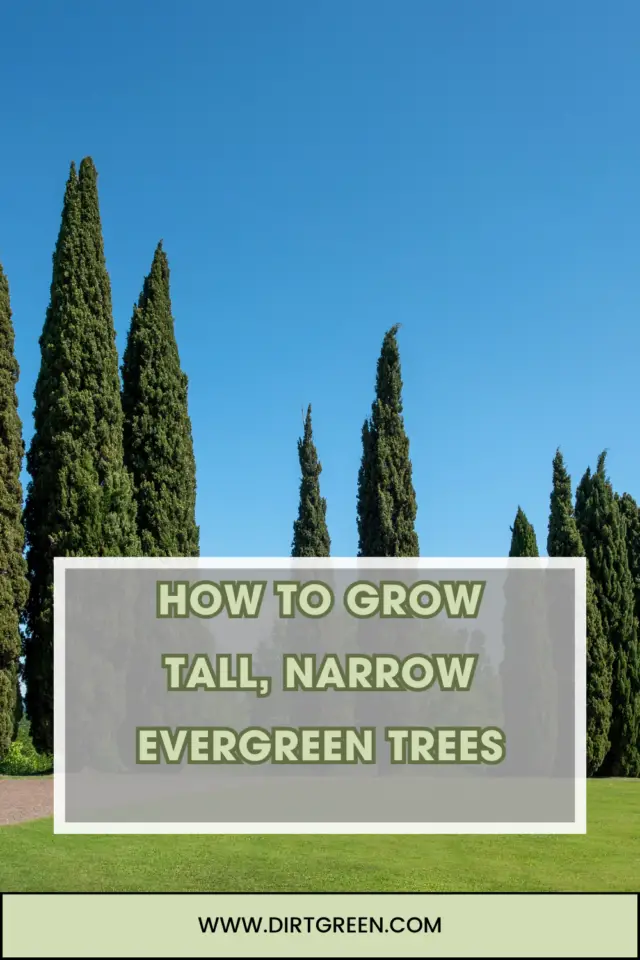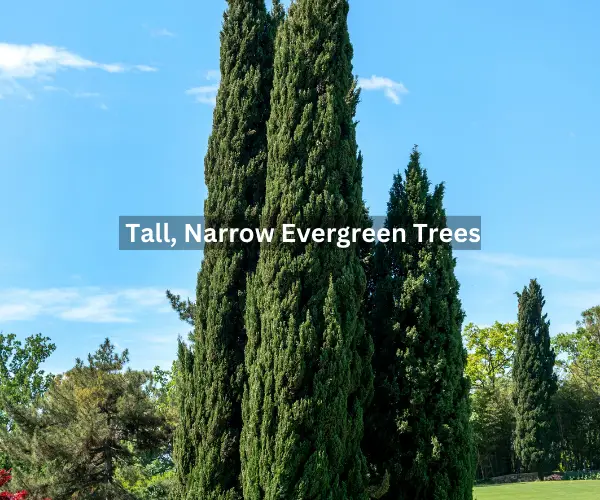If you’re looking to add some vertical interest and year-round greenery to your landscape, tall, narrow evergreen trees can be an excellent choice.
These slender trees can create striking accents, line pathways or driveways, or serve as privacy screens without taking up too much horizontal space.
While they require some special care, with the right planting and maintenance, you can enjoy the beauty of these columnar evergreens for many years to come.
Everything you need to know about choosing, planting, and maintaining tall, narrow evergreen trees will be covered in this extensive blog.

Choosing the Right Evergreen Tree
The first step is to select a species that is well-suited to your climate and growing conditions. Some popular choices for tall, narrow evergreens include:
Italian Cypress
One of the most iconic columnar evergreens, Italian cypress can reach heights of 40-60 feet with a spread of just 3-6 feet. It has a distinctive slim, pyramidal shape and deep green foliage. Italian cypress prefers full sun and well-drained soil, and it is hardy in USDA zones 7-10.
Emerald Arborvitae
A cultivar of the American arborvitae, Emerald Arborvitae is a dense, narrow evergreen that can reach 15-20 feet tall with a spread of just 3-4 feet. Its rich emerald-green foliage has a pleasant aroma, and it is hardy in USDA zones 2-7.
Sky Pencil Holly
As its name suggests, Sky Pencil Holly is an extremely slender evergreen that can grow up to 8-10 feet tall but only 1-2 feet wide. Its dark green foliage and ability to tolerate shearing make it a popular choice for formal gardens or hedges. It is hardy in USDA zones 6-9.
Swedish Columnar Aspen
While not technically an evergreen, the Swedish Columnar Aspen is a tall, narrow deciduous tree that can provide vertical interest even in winter with its whitish-gray bark. It can reach 40-50 feet in height with a spread of just 5-10 feet and is hardy in USDA zones 2-7.
When selecting your tree, consider factors like mature size, growth rate, and maintenance requirements to ensure it will fit well in your desired location.
Planting and Establishment
Proper planting is crucial for the long-term health and success of your tall, narrow evergreen tree. Here are some key steps:
1). Choose the right location: Most tall, narrow evergreens prefer full sun exposure and well-drained soil. Avoid areas with heavy clay or prone to standing water.
2). Prepare the planting hole: Dig a hole that is two to three times wider than the root ball but no deeper. This will encourage the roots to spread outward rather than downward.
3). Amend the soil: Mix compost or other organic matter into the backfill soil to improve drainage and nutrient content.
4). Plant at the proper depth: Position the tree in the hole so that the root flare (where the trunk meets the roots) is slightly above ground level.
5). Stake the tree: Tall, narrow evergreens can be susceptible to wind damage, so it’s important to stake the tree for the first year or two to stabilize it and allow the roots to establish.
6). Mulch: Apply a 2-4 inch layer of mulch around the base of the tree, leaving a few inches of space around the trunk. This will help retain moisture and suppress weeds.
7). Water thoroughly: Water the tree deeply after planting and continue to water regularly (every 7-10 days in the absence of rain) for the first 1-2 growing seasons to encourage root growth.
Ongoing Care and Maintenance
Once your tall, narrow evergreen is established, it will require some regular care and maintenance to keep it looking its best.
Watering
While established evergreens are generally drought-tolerant, they will still need supplemental watering during periods of extended dry weather. Apply water slowly and deeply to encourage deep root growth.
Pruning
Most tall, narrow evergreens benefit from periodic pruning to maintain their desired shape and size. Italian cypress, for example, should be pruned annually in late winter or early spring to remove any stray or wayward branches and encourage dense, upright growth.
Other evergreens, like arborvitae, can be lightly sheared or shaped as needed throughout the growing season. Always use clean, sharp pruning tools and avoid over-pruning, which can create bald spots or encourage excessive growth.
Fertilizing
Evergreens have modest fertilizer needs, but a light application of balanced fertilizer or compost in early spring can give them a nutritional boost. Be careful not to over-fertilize, which can promote excessive growth and make the trees more susceptible to pests and diseases.
Mulching
Maintain a 2-4 inch layer of mulch around the base of your tree, replenishing as needed. This will help retain moisture, suppress weeds, and protect the shallow roots from temperature extremes.
Winter Protection
In colder climates, some tall, narrow evergreens (like Italian cypress) may benefit from being wrapped or protected during the winter months to prevent desiccation or cold damage. Use burlap or other breathable materials and remove them in early spring.
Potential Issues and Solutions
While generally low-maintenance, tall, narrow evergreens can sometimes encounter a few common issues:
Leaning or Blowing Over
The slender shape of these trees can make them susceptible to leaning or blowing over in high winds, particularly when young or newly planted. Proper staking and guying can help prevent this, as can choosing a more sheltered planting location.
Browning or Dieback
Browning or dieback of foliage can be caused by a variety of factors, including drought stress, cold damage, or pest/disease issues. Providing adequate water, mulching, and prompt treatment (if pests or diseases are identified) can help mitigate these problems.
Sparse Growth or Bare Spots
If left unpruned, some tall, narrow evergreens can develop sparse growth or bare spots along the trunk or interior branches. Regular, light pruning can help promote dense, uniform growth and maintain the desired columnar shape.
With their striking vertical form and year-round greenery, tall, narrow evergreen trees can be a beautiful and low-maintenance addition to any landscape.
Benefits from these thin sentinels can last for many years if you choose the right species, plant them appropriately, and give them some simple care and upkeep.
So why not add some vertical interest and evergreen elegance to your garden with one of these sophisticated trees?




